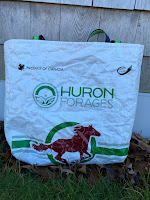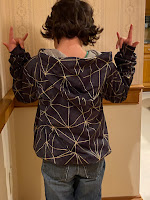This is for all of you out there using something other than your hands to raise and lower the presser foot on your sewing machines.
I have two Bernina sewing machines and both have the option to insert a rod like this into that little hole on the front. This view is on my 1001 model but my newer 350 model has it as well. Both came with the knee lift rods. The bend in the rod allows it to go under your table so you can "simply" press your knee against it and it will raise and lower your presser foot, hands free. I say "simply" in quotes because I have no idea how simple it is to use.Confession: I've had my Bernina 1001 for almost 30 years and a newer 350 but I've always been afraid to use the knee lift. Why? Two very silly reasons. For one, I don't know how to use it and never bothered to look at a video. But mostly because I've always been afraid that I'd get so used to it, I wouldn't ever be able to use a sewing machine that didn't have this option, no matter how good the rest of the options might be.
Anyone else out there have this problem? You have access to a modern convenience that will make your life so much better but you won't use it in case you love it and can't live without it? I'm looking at you, backup cam in my car. I refused to use it in case I become so reliant on it, I can't back up the old fashioned way. This happens more than I'd like which is a great example of irony because the very crux of my job is technology and how it can be leveraged to improve things.
This must be a GenX problem, right?
Back to why I've called you all here.
The more I see people in their videos appearing to magically raise and lower presser feet without no hands, the more I wonder why on earth I have two machines that will do this and refuse to bother. Isn't this the kind of thing I would LOVE? I'm all about efficiency and surely the micro milliseconds I will save not moving my hand to raise and lower the presser foot will make my life so much better, right? So I keep thinking, I should really figure this out.
And I sat down to think about thinking about it and came up with a new dilemma. How does the knee lift work if you have a standing desk? When I upgraded my sewing space a few years ago, I left behind the old sit at a table thing and put in a counter where all of my machines live. The 350 is missing from this picture but it sits to the left of the 1001 most of the time. I stand or use the stool. When I'm quilting or trying to sew something unwieldy like these grain bags, I bring it to a table so I can spread everything out. At that table I do sit, but when I'm doing anything else, I'm at this counter. I don't think I can stand and press the knee lift and the way I have everything arranged, I'm not sure I can sit on the stool and use it either. I know I could just try it and see what happens but I also know that if I use it once and LOVE it and then find out I can't use it in my current set up, I'm going to be so mad and rethink everything about the set up I like so much.It's very complicated here in my brain when I'm having such first world dilemmas.
I'd love to hear from you if you use a knee lift system and especially if you use it with a standing desk or something similar to mine.
















